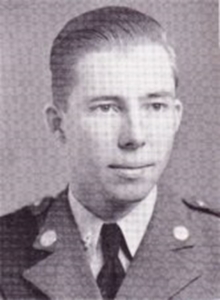Scroll of Honor – William Hunter Carson
The Critical Moment
Written by: Kelly Durham
William Hunter Carson of Orangeburg was a member of the Class of 1942, the first cohort to graduate from Clemson College after America’s entry into World War II. A textile engineering major, Carson was recognized as an honors student and was inducted into Phi Psi, the national textile honor society. He was also a member of the Tri-County Club which he served as secretary his junior year and president as a senior. In the Cadet Brigade, Carson was a member of B Company, 1st Battalion of the 2nd Regiment and was a member of the Freshman Platoon composed of the best drilled members of his class.
Despite never advancing beyond the rank of cadet corporal, Carson’s military college experience and educational achievement prepared him for active duty. He volunteered for the Army Air Force and qualified for pilot training.
By the spring of 1944, Carson was a multiengine aircraft pilot assigned to Boca Raton Army Airfield in Florida. The base was the headquarters for Army Air Force training on the developing technology of radar. In addition to classroom training in theory and application, personnel learned to maintain radar equipment and, most importantly, how to operate it in flight. With the technology assuming an increasingly important role for the Army Air Force, training operations were conducted virtually around the clock.
 On the morning of May 12, 1944, First Lieutenant Carson was assigned as the pilot of an RB-34 twin engine aircraft for a radar training mission. The RB-34 was a radar-equipped version of the Lockheed Ventura medium bomber. In addition to Carson at the controls of the aircraft, eight other crew members and trainees were aboard.
On the morning of May 12, 1944, First Lieutenant Carson was assigned as the pilot of an RB-34 twin engine aircraft for a radar training mission. The RB-34 was a radar-equipped version of the Lockheed Ventura medium bomber. In addition to Carson at the controls of the aircraft, eight other crew members and trainees were aboard.
During his pilot training, Carson learned of the four basic forces acting on an airplane in flight, including thrust, the force that moves an aircraft forward. In a simple single engine airplane, thrust is provided by the propeller mounted on the nose of the airframe and centered along its longitudinal axis. In the case of the RB-34, thrust was provided by its propellers, one on each wing.
As Carson completed his pre-flight checks and taxied onto runway 9, he was about to encounter a most difficult condition at the most critical moment of his flight. As Carson’s aircraft lifted from the runway and climbed to an altitude of thirty to forty feet, the left engine lost power. Within a fraction of a second, the aircraft’s thrust shifted from straight ahead to asymmetric. All of a sudden, the existing power and thrust provided by the right engine and propeller overwhelmed the lack of thrust from the left. The aircraft yawed violently to the left, its left wing dropping and colliding with the ground. The bomber cartwheeled into the ground, breaking the fuselage in two and separating both engines from the wings. The aircraft then burst into flames.
The official accident report concluded, “The crash was due to the loss of power of the left engine shortly after the take-off at the critical time when a successful single engine operation would be extremely difficult.”
William Hunter Carson was survived by his parents, a sister, and two brothers, one then in the Army, the other serving in the Navy. He was buried in Memorial Park Cemetery in Orangeburg.
For more information about First Lieutenant William Hunter Carson see:
https://soh.alumni.clemson.edu/scroll/william-hunter-carson/
For additional information about Clemson University’s Scroll of Honor visit:
https://soh.alumni.clemson.edu/
